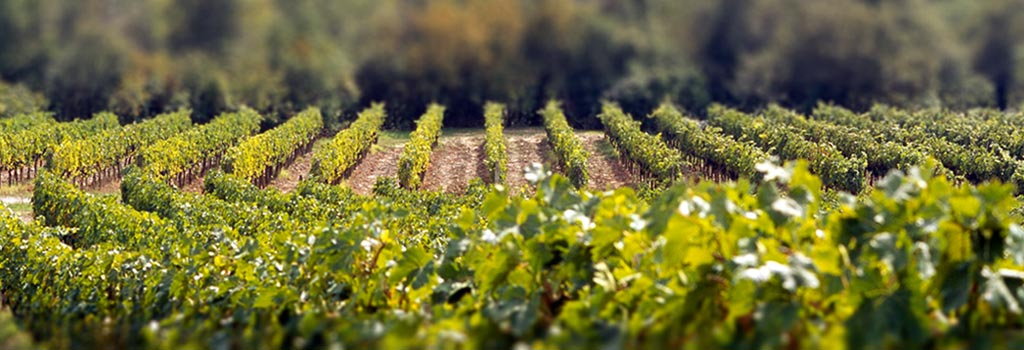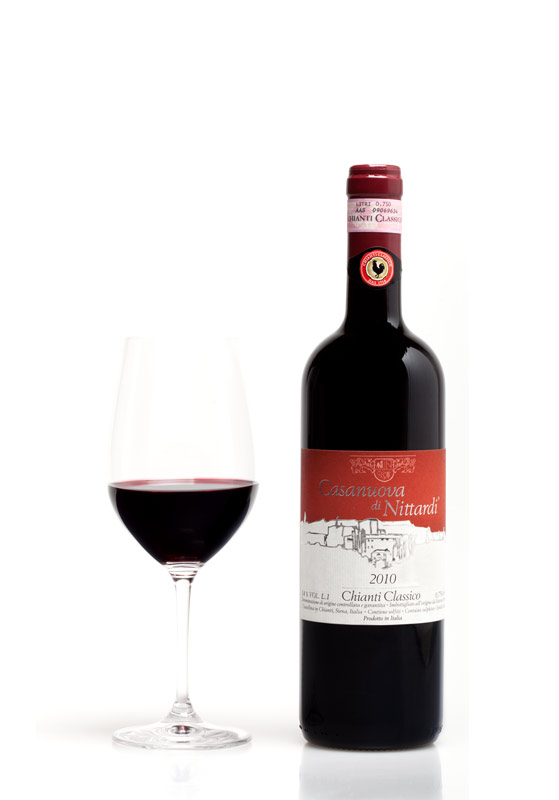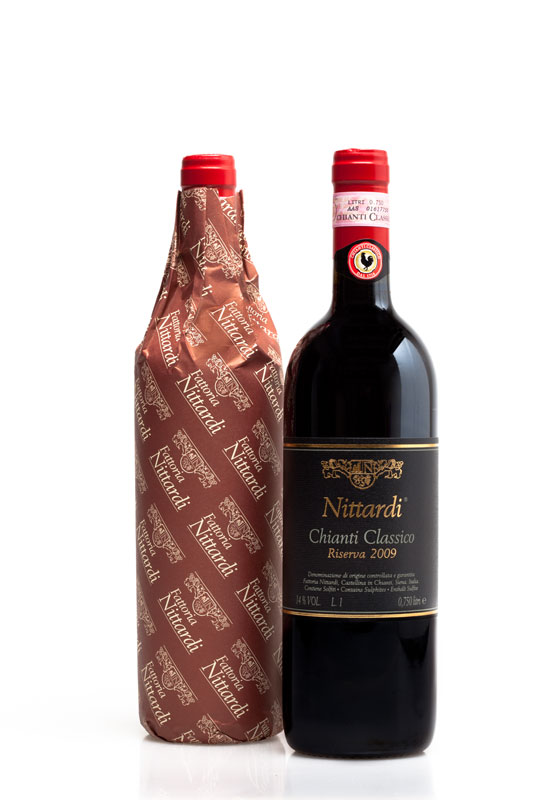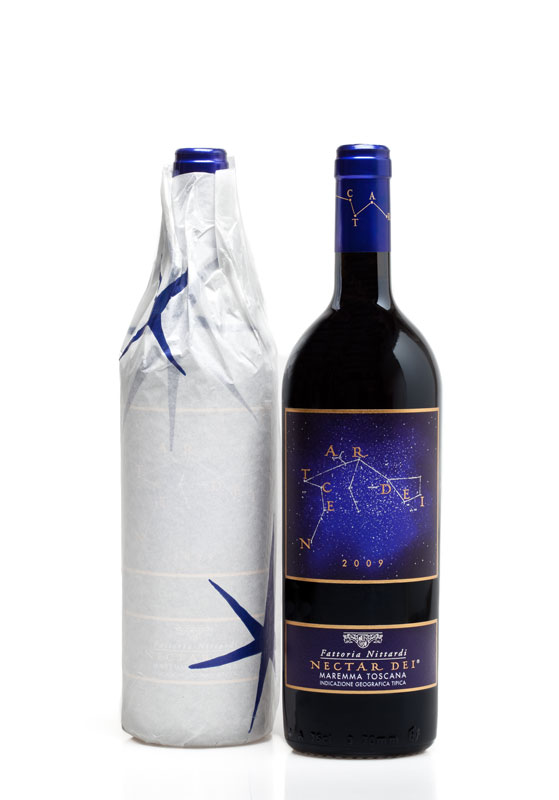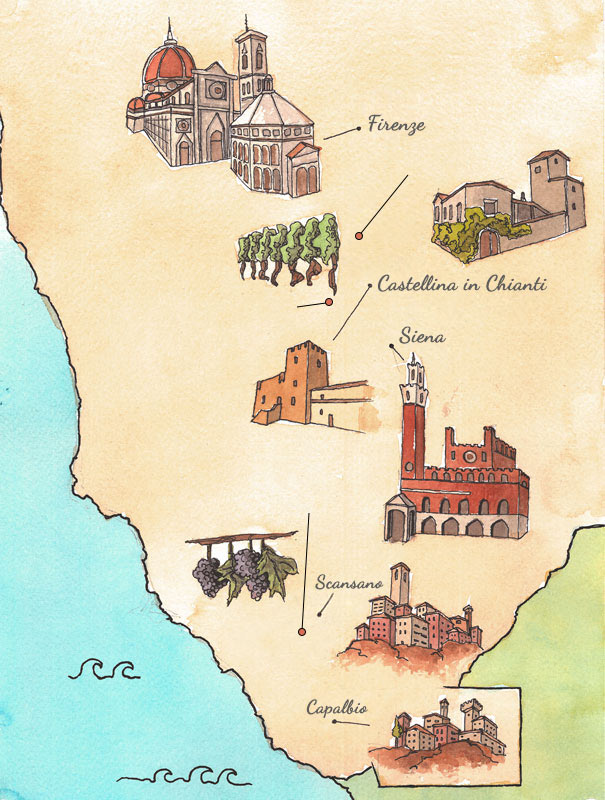Casanuova di Nittardi
This Chianti Classico represents the essence of our Sangiovese vineyards at Nittardi. A limited edition of bottles has an artist label and wrapping paper created every year by a different artist.
Denomination:
Chianti Classico
Grape Varieties:
Sangiovese, Canaiolo Nero
Nittardi riserva
Produced only in very good vintages this Riserva Selezionata represents the soul of Nittardis terroir.
Denomination:
Chianti Classico Riserva
Grape Varieties:
Sangiovese, Merlot
Ad Astra
Our second wine from Maremma is a Mediterranean and wild wine, as the region where he comes from.
Denomination:
IGT Maremma Toscana
Grape Varieties:
Sangiovese, Cabernet Sauvignon, Merlot, Syrah
Nectar Dei
Our super-premium wine from Maremma is a powerful yet complex and intriguing wine.
Denomination:
IGT Maremma Toscana
Grape Varieties:
Cabernet Sauvignon, Merlot, Petit Verdot, Syrah
Ben
Our first white wine produced with the Tuscan grape variety Vermentino comes from our vineyards in Maremma.
Denomination:
IGT Maremma Toscana
Grape Variety:
Vermentino
The Vineyards at Nittardi
The vineyards of Nittardi represent the heart of the estate. Our vineyards produce outstanding fruit year after year thanks to an interesting soil mix of slate and schist combined with a mesoclimate with extreme day-to-night temperature differences. In total, at the Nittardi estate itself, we have five different plots of 9 hectares each. The youngest vineyard (Doghessa) is planted at the high density of 6,667 plants per hectare, while the other vineyards have a per-hectare density of 5,500 plants. All the vineyards are cordon-pruned and the average production is less than one kilogram per plant, or between 35 and 45 hl per hectare.
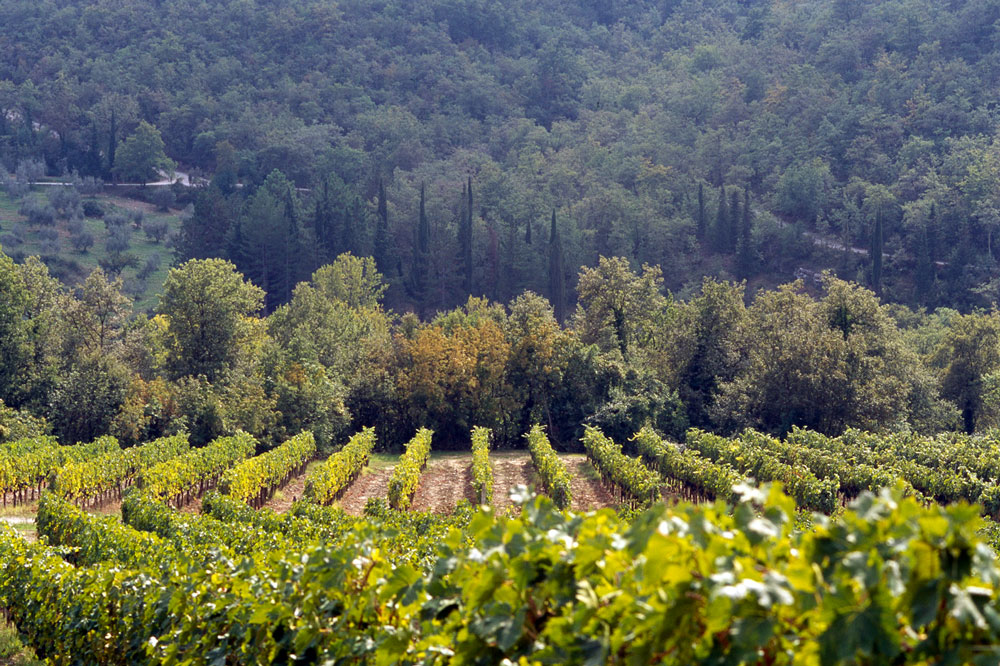
Grape varieties: We have two different grape varieties in the vineyards surrounding Nittardi: Sangiovese (six different clones, so as to get a variety of different expressions from the same terroir) and a tiny bit of Merlot (three different clones).
Soils: The different parcels have the same limestone-clay mix in common. At the same time, the soil of the vineyards has a rich skeleton of shingle and stones, in particular Galestro, a type of schist that is typical of the Chianti Classico area. The less steep vineyards have a deeper soil that is less rich in texture. These different soil types, combined with the region's interesting mesoclimate, are an excellent terroir for Sangiovese!
Climate: The climate at Nittardi can be defined as continental, with low temperatures during the winter, often under zero degrees, and warm and dry summers, with daily temperatures above 30 degrees. The extreme variances in the day-to-night temperatures, due to the high altitudes varying between 400 and 500 meters as well the southern exposure, are noteworthy and influential. The yearly rainfall, around 800 millimeters, is concentrated between late autumn and spring. These climatic characteristics guaranty a slow and balanced maturation of the grapes: the starting point of elegant and complex wines.
Agricultural practices: Even if we are not yet certified, all our vineyards are managed organically and with the highest respect for the environment. Fertilization of the soil is carried out only with organic substances, such as manure and green manure (seeding, growth, chopping and burial of leguminous plants such as field beans). Throughout the year, our skilled workers conduct all operations in the vineyards manually. To ensure a better quality grape, we keep the amount of grapes produced low through a variety of agricultural methods, such as short-pruning in winter, a careful selection of the shoots in spring, and green harvesting in early summer. The harvest, of only the ripest and healthiest grapes, is done manually.
Harvest: The first variety to be harvested is normally the Merlot, in early September, while we harvest the Sangiovese grapes at the end of September and beginning of October.
The San Quirico Vineyard
This old vineyard is located close to the beautiful hamlet San Quirico, south of Castellina in Chianti. Most of the vineyard is over 40 years old, while a small parcel was replanted in 2010 with a high density of 6,667 plants per hectare. All the vines are cordon-pruned and the vineyard produces on average 45 hl per hectare.
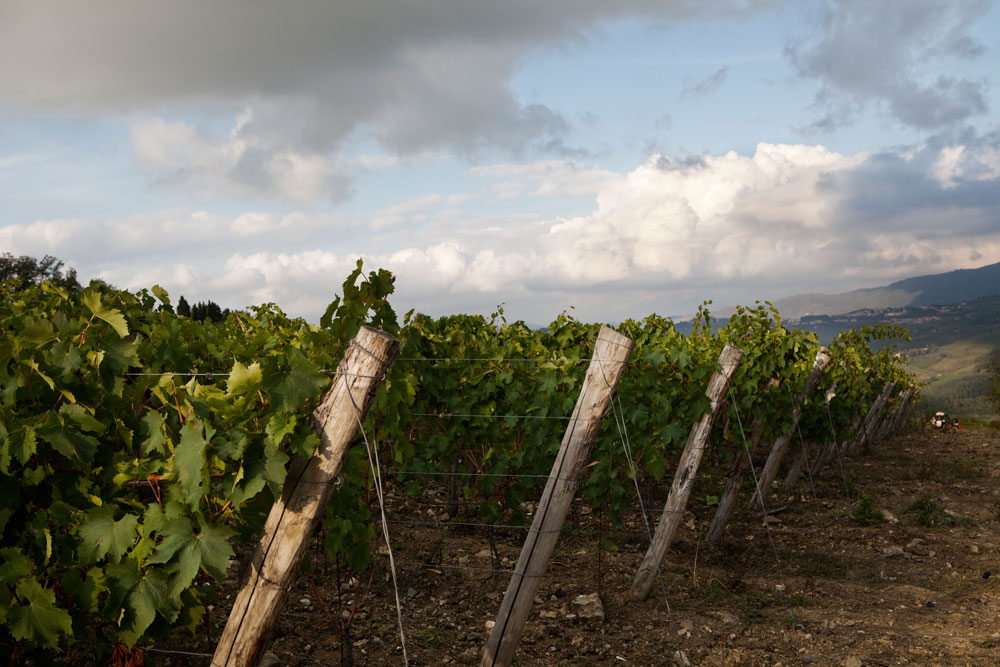
Grape varieties: Massal selection of Sangiovese and Canaiolo.
Soil: The vineyard is characterized by a limestone-clay mix with a rich skeleton consisting of shingle and stones, in particular Galestro, a special type of schist that is typical of the Chianti Classico area. This soil of fine clay and very little organic substance drains water well. Combined with the region's interesting mesoclimate, this terroir is perfect for Sangiovese!
Climate: The climate in San Quirico can be defined as continental, with low temperatures during the winter, often around zero degrees, and warm and dry summers, with daily temperatures often above 33 degrees. The variances between day and night temperatures are notable. The yearly rainfall, around 800 millimeters, is concentrated between late autumn and spring. These climatic characteristics guaranty a slow and balanced maturation of the grapes: the starting point of elegant and complex wines.
Agricultural practices: Even if we are not yet certified, all our vineyards are managed organically and with the highest respect for the environment as well as the people who work them. Fertilization of the soil is carried out only with organic substances, such as manure and green manure (seeding, growth, chopping and burial of leguminous plants such as field beans). Throughout the year, our skilled workers conduct all operations in the vineyards manually. To ensure a better quality grape, we keep the amount of grapes produced low through a variety of agricultural methods such as short-pruning in winter, a careful selection of the shoots in spring, and green harvesting in early summer. The harvest, of only the ripest and healthiest grapes, is done manually.
Harvest: Canaiolo Nero ripens first and is harvested around the middle of September. At the end of September we normally harvest the Sangiovese grapes.
The Mongibello delle Mandorlaie Vineyards
Our vineyards in Maremma are south of Scansano and close to Montiano, only eight kilometers from the seaside. Our adventure in Maremma started with our vision of producing wines that reflect this Mediterranean and wild terroir and, subsequently, in 1999, our purchase of the beautiful piece of land known locally as “Mongibello delle Mandorlaie”. We have planted seventeen hectares here to date, each with a density of 6,667 plants per hectare. Most of the vines are cordon-pruned, while a part of the Cabernet Sauvignon is guyot-pruned.
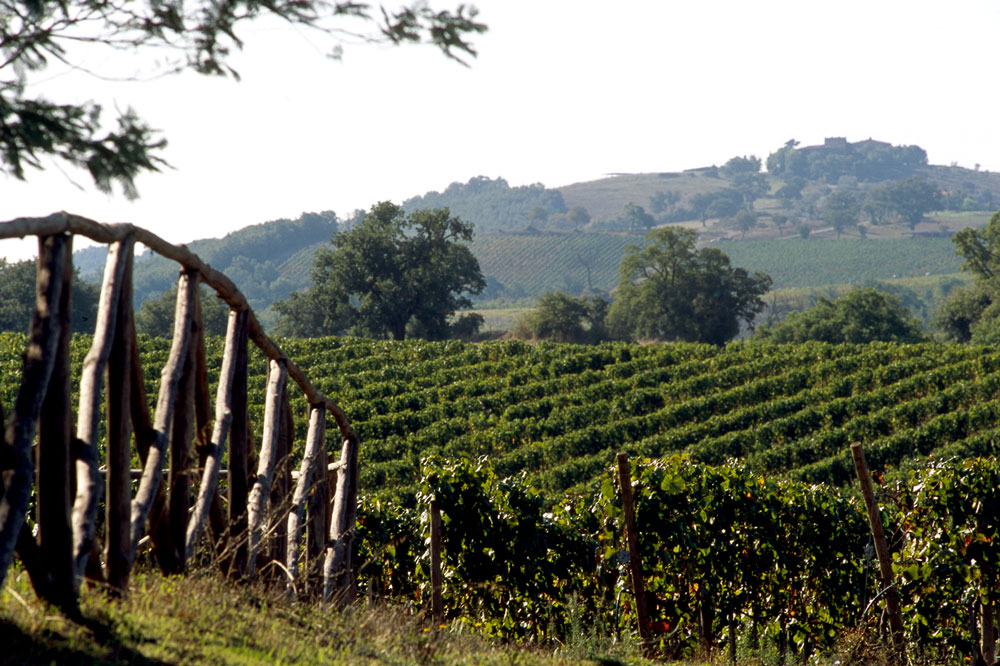
Grape varieties: Over the years we have planted seven different grape varieties: Sangiovese, Cabernet Sauvignon, Alicante Bouchet, Petit Verdot, Merlot and Cabernet Franc. We have also planted some small parcels of experimental grape varieties with the aim of gaining a better understanding of the terroir in Maremma.
Soil: The soil of the entire vineyard is characterized geologically by a kind of sandstone known as Macigno del Chianti. The thick layer of sand and reddish ocher color characteristic of the local terrain are the result of the erosion of this sandstone. This type of land, particularly poor in nutrients and water, encourages the plants to root deeply.
Climate: The region has a typical Mediterranean climate with mild winters and dry summers. Average yearly temperatures are around 16° C. The rainfall in southern Maremma is one of the lowest in all of Tuscany, with an average of 500 mm per year. Most of the rain falls during late autumn, winter and spring. Special to the area is also the high amount of sun hours, which is due to the lack of mountains and the exceptional mesoclimate with little rainfall and few clouds.
Agricultural practices: Even if we are not yet certified, all our vineyards are managed organically and with the highest respect for the environment. Fertilization of the soil is carried out only with organic substances such as manure and green manure (seeding, growth, chopping and burial of leguminous plants such as field beans). Throughout the year, our skilled workers conduct all operations in the vineyards manually. To ensure a better quality grape, we keep the amount of grapes produced low through a variety of agricultural methods such as short-pruning in winter, a careful selection of the shoots in spring, and green harvesting in early summer. The harvest, of only the ripest and healthiest grapes, is done manually.
Harvest: The first variety to be harvested, at the end of August, is normally Merlot; followed by Alicante Bouchet and Syrah. In the middle of September, we start with Cabernet Sauvignon, Cabernet Franc and Sangiovese. The last grape to be harvested is Petit Verdot – which has shown outstanding results in our vineyards – at the beginning of October.

